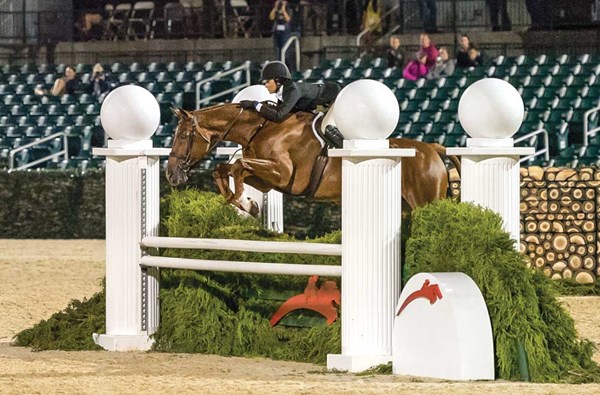 This year’s USHJA International Hunter Derby Championship winner Kristy Herrera approached the turn to Fence 2 slowly so she and Miss Lucy could come forward out of it, making the long seven strides to Fence 3 easier.
This year’s USHJA International Hunter Derby Championship winner Kristy Herrera approached the turn to Fence 2 slowly so she and Miss Lucy could come forward out of it, making the long seven strides to Fence 3 easier.Imagine this: You canter into the stadium under the bright lights in front of more than 1,000 cheering spectators and attempt to navigate a tricky handy-hunter course of 11 fences, ranging in height from 3-foot to 4-foot-9, plus an imposing final wall. For even the most experienced professional rider it’s a big night, a big deal and a big challenge.
But for Kristy Herrera, the winner of this year’s United States Hunter Jumper Association International Hunter Derby Championship at the Kentucky Horse Park in Lexington, the challenge was especially daunting. Her mount, Helen Lenahan’s Miss Lucy, was a catch-ride whom Kristy had been riding for only two weeks.
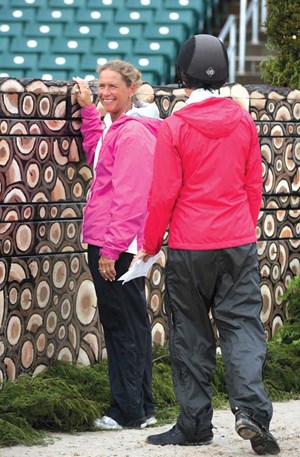 Trainer Jennifer Alfano stands next to the handy-hunter round’s final fence, a 5-foot-1½-inch-tall wall. Miss Lucy’s usual rider, Jennifer, had to sit out this year’s competition because of an injury, so her former student Kristy Herrera (red coat) rode the chestnut mare.
Trainer Jennifer Alfano stands next to the handy-hunter round’s final fence, a 5-foot-1½-inch-tall wall. Miss Lucy’s usual rider, Jennifer, had to sit out this year’s competition because of an injury, so her former student Kristy Herrera (red coat) rode the chestnut mare.An experienced horse, Miss Lucy had been a winning staple on the derby circuit with rider and trainer Jennifer Alfano in the saddle. And Jennifer had won the 2012 derby championship with Jersey Boy, so she was no stranger to the class. But in May, Jennifer badly injured herself in a fall at the Devon Horse Show, triggering several months of surgery and recovery time. When she couldn’t make the championship trip on Miss Lucy herself, she wanted her former student to ride the talented but particular chestnut mare.
“It would have been hard to hand the reins over if it was anybody other than Kristy,” Jennifer explained. “We have a longstanding relationship, so that makes it easier. It was important that Kristy and I are so close. Since she didn’t know the horse, she had to put her trust in me.”
That confidence paid off when Kristy successfully hand-galloped the 14-year-old mare to the handy round’s final fence, a cordwood wall set at 5-feet-1½ inches tall. The pair won the 2016 championship with a composite score of 587 compiled over the two days of competition, edging out Kelley Farmer’s ride, Kodachrome, by five points.
The championship is the culmination of more than 70 derby events during the year and includes both a classic and a handy round. This year, 40 of the 66 horses competing in the championship advanced to the handy round held on Saturday night, Aug. 20, at the Sheila C. Johnson Arena.
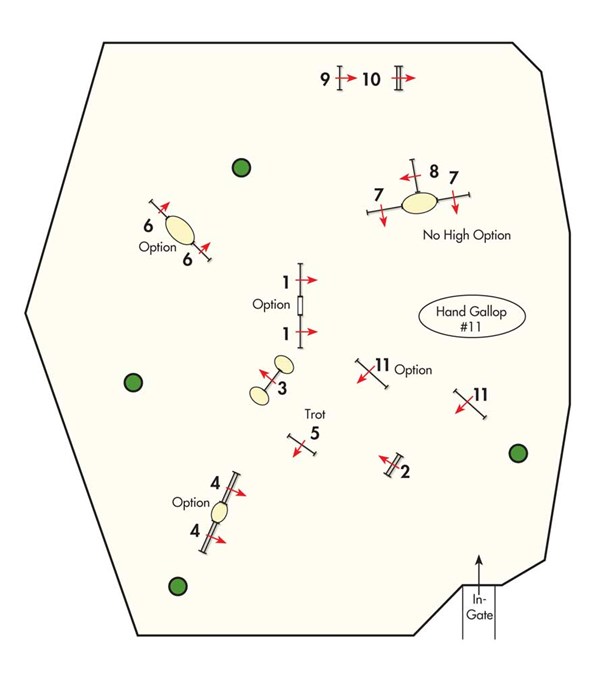
Six judges in three judging panels of two scored each horse-and-rider pair. Riders received an extra point from each panel for each high fence option that was taken. Each panel could also award up to 10 bonus points per rider based on the handiness of the trip. The composite score from both the classic and handy rounds determined the final placements.
The tracks for the derby championship were crafted by course designers Danny Moore and Bobby Murphy, who wanted to deliver a traditional hunter course that would still provide enough technical difficulty to separate the field. Despite the handy course’s tight turns and hefty high options, Kristy said she felt confident on Miss Lucy because “there is nothing you can’t point her at. She is an amazing horse. All the scope and power is there. I just mostly tried to leave her alone and trust that she has the scope, that you can just canter on a loose rein up to an enormous jump and she takes care of it.”
Judge Tom Brennan said that Kristy and Miss Lucy were “consistently excellent” throughout the championship weekend and that their overall performance snagged them the championship. “Miss Lucy was extremely competitive in the handy, but where she won the championship was her consistency over the two days,” Tom explained. “She was handy enough to be competitive with the bonus points but not the handiest. Where she really beat the field was a steady and consistent performance with some risks. The mare jumped very well. She jumped over and over in the same correct style that we were looking for. There really wasn’t anything you could fault her on.”
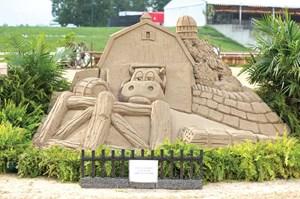 A sand sculpture depicting a cow peeking out of a barn sat between the high and low options of Fence 6. Course designers Bobby Murphy and Danny Moore included 10 custom-built sand sculptures as part of the championship’s fence design.
A sand sculpture depicting a cow peeking out of a barn sat between the high and low options of Fence 6. Course designers Bobby Murphy and Danny Moore included 10 custom-built sand sculptures as part of the championship’s fence design.Here is a fence-by-fence breakdown of the handy round, including Kristy’s thoughts on how she navigated this challenging course as well as some commentary from Jennifer—an understandably nervous coach and spectator.
Fence 1: Picket Gate and Hedge
Height: High option on right, 4 feet 7 inches; low option on left, 3 feet 10 inches
Construction: A vertical with brush racks set behind a white picket gate. Each option was 18 feet across (from left to right) and the brush rack was 16 inches deep.
Course Designer Notes: The riders cantered into the center of the ring and turned back to Fence 1, heading toward the grandstand. More ground lines had been added to this fence after the classic round because some horses were struggling to jump it in good form. “We were looking for the horses to jump this beautifully,” Bobby said. “There was no rail to be knocked down. It was the centerpiece of the ring and the horses were saying, ‘Hello, I am here to start my course.’”
By design, both options of the first fence could be reached off either the right or left lead. “This course was about equality,” Bobby said. “We wanted horses that favored either lead to have an equal start.”
Kristy: The most important thing Jen said to me was to ride this like a first round and turn tighter. That was helpful as sometimes I can get over-ambitious in handy rounds and try too hard. I was nervous but also confident in Lucy. So I walked in and said to myself “Come on, we can do this.”
The first thing was to just pick up a good gallop. Galloping is part of being handy so I was just trying to show off going forward. I had to slow into that turn and the distance came up a bit short, but Lucy is so good at making room that it worked out really well.
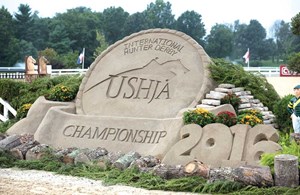 Fence 3 was flanked on the right by a sand sculpture of the USHJA logo.
Fence 3 was flanked on the right by a sand sculpture of the USHJA logo.I jumped the first jump and knew we were good. That was a pretty big gate. It was an amazing feeling in the air and the first high option. It went so well that it gave me confidence and allowed me to start thinking ahead.
Jennifer: We went over the course—about a hundred times—and then I said, “Good luck and have fun.” I just wanted it to go well, be fun for Kristy, but I was pretty nervous. I was a little beside myself. I am not a very good spectator. I was pacing up and down. And believe me, I jumped every jump with her.
Kristy follows instructions incredibly. Everything I said to do she executed. Once she started out, I was worried about the turn from Fence 1 to 2—it was tight. Lucy is big and long and she turns like a school bus. Once she got through that turn and to Fence 2, I had a good feeling about it.
Fences 2 and 3: Oxer to Vertical
Height: Both fences in the seven-stride line were set at 3 feet 10 inches.
Construction: Fence 2 was an oxer framed by large white columns. It included three sections of brush rack, a white Riviera gate in front and double rails in the back. Fence 3 was the first sand sculpture fence: a vertical bridge of brush flanked by sand sculptures of a blue ribbon and the USHJA logo.
Course Designer Notes: This fence required a tight right turn inside Fence 11 to get straight for the line, which headed away from the in-gate. “Fence 2 was just a beastier version of Fence 1,” Bobby said. “We just wanted to get the horses adjusted. But the distance of 103 feet from oxer to vertical created a technicality for them to ride. The horses needed to be athletic to make that inside turn.”
Kristy: You had to approach that turn strategically because the oxer was wide and the line was angled over to the right. If you cut the turn, you were going to be heading to the left and it would make the line longer. I tried to approach the turn slowly so I could come forward out of it. Miss Lucy jumped it so well going over the oxer, it helped going down the seven easily.
Fence 4: Natural Rail Oxer
Height: High option on left, 4 feet 9 inches; low option on right, 3 feet 9 inches
Construction: An oxer of natural rails set on an angle heading toward the in-gate. A sand sculpture depicting the Chicago Hunter Derby in the front and a fox-and-hound scene in the back sat between the high and low options. The high option had a 4-foot spread and was 12 feet across, the low option had a 3-foot-9 spread and was 16 feet across.
Course Designer Notes: A handy left turn to the angled oxer. The narrower high option was on the left, making the turn more challenging. “At this point in the course, we needed to turn left,” Bobby said. “And we decided to go with rails, so in the end we added an additional rail to make this fence look more solid.” This was one of the total of three oxers on the course required by U.S. Equestrian Federation rules.
Kristy: For the entire turn, I had to think about getting to the base of the fence because it was a big oxer that some horses had had trouble with. But it came up nicely out of stride. She jumped the hell out of it. I just grabbed braids and was able to stay on.
I landed and heard someone whistle. Then I had to stay centered and make the next turn to the trot jump.
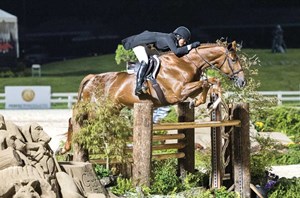 Kristy jumped the high option (4-feet-9-inches) of Fence 4, a 4-foot-wide oxer with natural rails.
Kristy jumped the high option (4-feet-9-inches) of Fence 4, a 4-foot-wide oxer with natural rails.Fence 5: Trot Fence
Height: 3 feet
Construction: A natural log. Spread was approximately 2 feet 6 inches to 3 feet, slightly narrower in the center.
Course Designer Notes: This rustic log was borrowed from the cross-country course on the other side of the Kentucky Horse Park. Bobby called its placement “a fitting place for the trot fence because the rollback allowed time for the riders to adjust to handle the trot.”
Kristy: Jen and I talked about getting pretty straight to this. It was a solid fence being a log and a little wide so you couldn’t angle it. But Lucy is such a good trot jumper. She so politely stepped over it like it was a crossrail. That made the landing so nice so we could go forward to the next jump.
Fence 6: Classic Log Aiken
Height: High option on right, 4 feet 9 inches; low option on left 3 feet 8 inches
Construction: This imposing yet traditional log-and-brush fence was named “Danny and Bobby’s Barnyard” in honor of the course designers and the sand sculpture between the options which depicted a cow peeking out of a barn. It was composed of long stacked logs with brush ramped against the fence on the approach. The short logs on top of the fence were cut in 2-foot sections and set in a shallow trough so that they would roll off if clipped. On the landing side, cutout figures of a opossum, chickens and a fox hiding in a tree added to the theme.
Course Designer Notes: Turning right after the trot fence, riders cantered across the top of the arena to ride either option of Fence 6, which was set on an angle. This fence had a vertical plane but it rode more like a triple bar due to the brush leading up to the log, Bobby said. “We were looking for the rider to just drop the reins and ride up to the base of that fence.”
Kristy: At that point, I was halfway through the course. I always try to break up a course and think about it in pieces. So I was starting over, I had to gear up again after the trot fence.
That fence didn’t bother me. It was easy to jump the day before and there was lots of brush on it. And Lucy jumps all the jumps pretty much the same, so you just have to hang on for the air time.
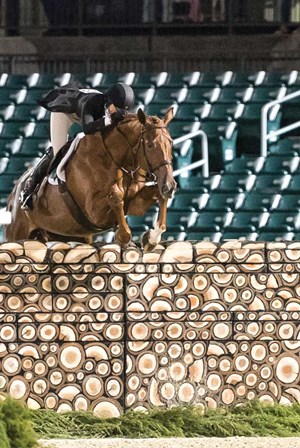 Kristy didn’t look at Fence 11, the last jump of the course, until seven or eight strides before it in order to avoid finding a too-long distance.
Kristy didn’t look at Fence 11, the last jump of the course, until seven or eight strides before it in order to avoid finding a too-long distance.Jennifer: I was really confident at that point because things were going so beautifully. Kristy really is a thinker when she rides. It was all coming together.
Fence 7: Kentucky Racetrack
Height: 3 feet 10 inches on both sides
Construction: A pair of inviting verticals with a 3-foot hedge spread. This fence mimicked a racetrack rail and was made of hedge, brush and a row of hollies. The standards were Churchill Downs spires, and the sand sculpture between the fences honored Triple Crown champion American Pharoah.
Course Designer Notes: A quick right turn to pick either the right or left side of this fence but no height option. Riders had lots of room to negotiate the correct angle to set up the rollback to Fence 8, as both sides were 20 feet across.
Kristy: I jumped the fence on the right because it was the handiest approach and it also made a nicer and handier turn to the sand jump (Fence 8). The track always affects distance so as I was coming into the jump, I saw the distance nicely and could keep on that angle.
Fence 8: Sand Fence
Height: 3 feet 8 inches
Construction: A unique vertical made of packed sand with a 3-inch foam topper covered in artificial grass.
Course Designer Notes: The week before the derby, the media were invited to view the ongoing construction of the sand sculptures in the arena. “Somebody asked me if the horses were actually going to jump the sand,” Bobby said. “And I said, ‘Yes they are.’ So I locked myself into this concept and I knew we had to do it.” While the sand fence was cured with glue, it would likely not survive a major misstep from one of the horses. “We took a lot of precautions to make it work,” Bobby said. “But I told everyone, ‘Don’t crash through this fence because there is going to be a picture of it in the media for sure.’”
Kristy: I was a little bit patient out of the turn, but Lucy can jump from a standstill, so I was still able to keep her together. I guess it was lucky that I went late in the class and nobody had ruined the fence. It was just a neat turn to the fence.
Fences 9 and 10: Wagon Wheel In-and-Out
Height: Fence 9 (the vertical in) was 3-foot-9 with a single rail sitting atop a roll top with a 3-foot spread. Fence 10 (the oxer out) was 3-foot-9 with a 3-foot-9 spread from rail to rail.
Construction: Grass walls with natural birch poles on top. The vertical in was 12 feet across (left to right), the oxer out was 16 feet across. Flanked by 6-foot-tall wagon-wheel standards.
Course Designer Notes: The riders cantered away from the sand fence and faced a tight rollback to the right, directly to this challenging two-stride combination. It was set long at 39 feet. “This combination was the final test of the scope of the horse,” Bobby said. “They rolled back to it, and the distance was long so it created a strategic challenge. We wanted them to show that athletic ability and scope and canter through the in-and-out with pace and brilliance.”
Kristy: I saw it ride long for other people so I wanted to be straight. As I was heading to the in-and-out, I said to myself aloud, “Just keep it together.” Probably the judges heard me. I just tried to stay out on the turn and gear back up, and I caught it forward coming out of the turn. From some of the pictures I’ve seen, Lucy’s best jump was the out.
Fence 11: Hand-Gallop To the Wall
Height: High-option wall, 5 feet 1½ inches; separate low-option fence, 3 feet 9 inches
Construction: Designed to look like a resting horse, the wall was made out of cordwood blocks, brush and artificial turf. The horse head was 10 feet 6 inches tall, and the entire face of the fence was 28 feet across (left to right) with the jumpable portion being 14 feet across. Including the brush and hedges on the approach to the wall, the spread was approximately 5 feet.
The low option for Fence 11 was a separate serpentine ivy wall topped with blocks set on a separate track about 20 feet to the right of the wall.
Course Designer Notes: The front of the wall was banked with greenery to make it “as inviting as a fence can be,” Bobby said. “Even though it was a wall, it was a triple bar and it jumped that way. Those riders could go right up to the base.
“The thing about that wall, it was an optional fence,” Bobby added, noting that almost all the 25 riders in the championship final chose the high option on Fence 11. “It was actually less inviting to jump the curved serpentine wall than to jump the big horse wall. We didn’t put as much ground line there. Using the serpentine, the rider had to pick a point on the fence, look straight through the horse’s ears and pick a spot, keep straight and hope that they didn’t have a block down.”
Kristy: I really wasn’t intimidated by the height of the last jump, and Jen told me it was my only option on Lucy. When we walked the course I just thought it was about the height of the grand prix jumps I’ve gotten to do this summer, and knowing Lucy’s scope, I was really confident about it.
I tried to show the hand gallop early, then balance. I have a tendency to let my eye get long when the jump is far away. So I didn’t look at that wall until I was seven or eight strides out, just so I wouldn’t look too early and get desperate to it. Luckily it just came up exactly the way I wanted, I could still move up but it wasn’t too long.
At that point I didn’t know I was winning until the score came up. I’ve learned not to think about winning when I’m in the ring because then I forget to think about riding. Winning doesn’t happen until the whole course is finished.
It was pretty big to hear everyone in the grandstand yelling. When we landed, I was so relieved that I did what I was there for. I was trying to do the course one jump at a time, not rush Lucy and let her perform like she knows how. She is such a professional at that class. I knew if I put her in the right position, it would work out.
Jennifer: I almost couldn’t even watch the last jump. I’d look away, then look back. Honestly, if I was on a catch-ride there is no way I would have cantered down to that jump. Kristy rode it perfectly, just like it was another jump … no speed up, no slow down, just galloped down and rode it out of stride.
Once she cleared the wall, I was hysterical, screaming and crying. It was really a special moment.
Setting a New Standard
With the U.S. Hunter Jumper Association International Hunter Derby program heading into its eighth year, course designer Bobby Murphy wanted to shake things up a little bit. “There has always been a saying in this industry that the hunters don’t jump that big,” Bobby said, referencing the aggressive high options and the daunting 5-foot-1½-inch wall in this year’s championship handy round. “But there needs to be a time when the hunters are challenged. The wall was a big jump. And that jump is the moment that the hunters proved their equality with the jumpers.”
In addition, Bobby and co-designer Danny Moore set a new derby standard for creativity by including 10 unique, custom-built sand sculptures as part of the fence design. “I saw the idea in 2010 for the World Equestrian Games here in Lexington. Joseph-Beth Booksellers had a huge sand sculpture that represented all the disciplines of the WEG. That is the moment that the idea began to brew in my mind,” Bobby said.
Team Sandtastic out of Sarasota, Florida, built the sand sculptures using more than 125 tons of sand and more than 20 gallons of glue. “The logistics were a lot more than I anticipated,” Bobby admitted. “I thought we would put plastic down, dump some sand and carve some sculptures. But it was a lot more difficult than that. Plus we had weather to deal with. A Kentucky storm coming through and [show manager] Hugh Kincannon and [my father] Rob Murphy had a 20-man team putting tents up to protect it. It was a wild ride.”
The course construction was “large scale” and a secondary team worked through the wee hours of the night throughout derby week to pull it together, Bobby said. The team even built a small jump (Fence 8) out of sand—a first for the derby program. And in a return to tradition, this year they added in a hand-gallop and a trot fence, which had been missing from the championship course for several years. That was a request from Ron Danta, head of the USHJA International Hunter Derby Committee, who wanted to ensure that the novel course design still reflected the history of the hunter sport.
This year’s challenging course had been a “steppingstone” for the derby program, Bobby said, adding that in 2017 the riders can expect 4-foot-3-inch and 4-foot-6-inch-high options in the quest to have a derby horse get a perfect score. “I think we wrote the perfect script with this course. But it doesn’t always have to be a hunter puissance,” Bobby said. “For 2017, it’s not about a big wall. It’s about a perfect score.”
This article originally appeared in the November 2016 issue of Practical Horseman.
SaveSaveSave






